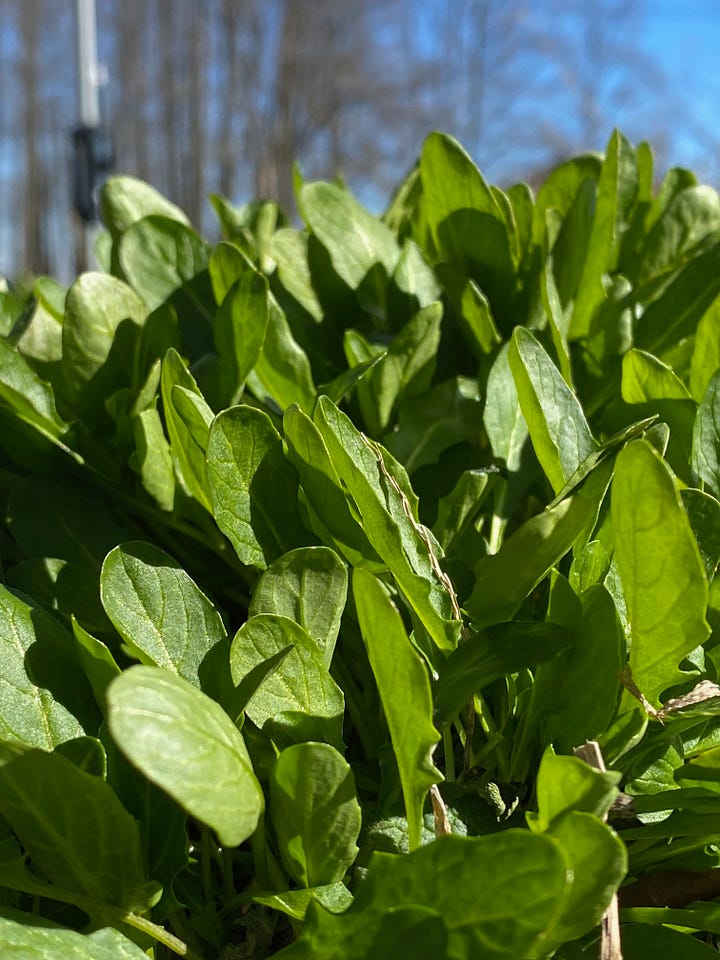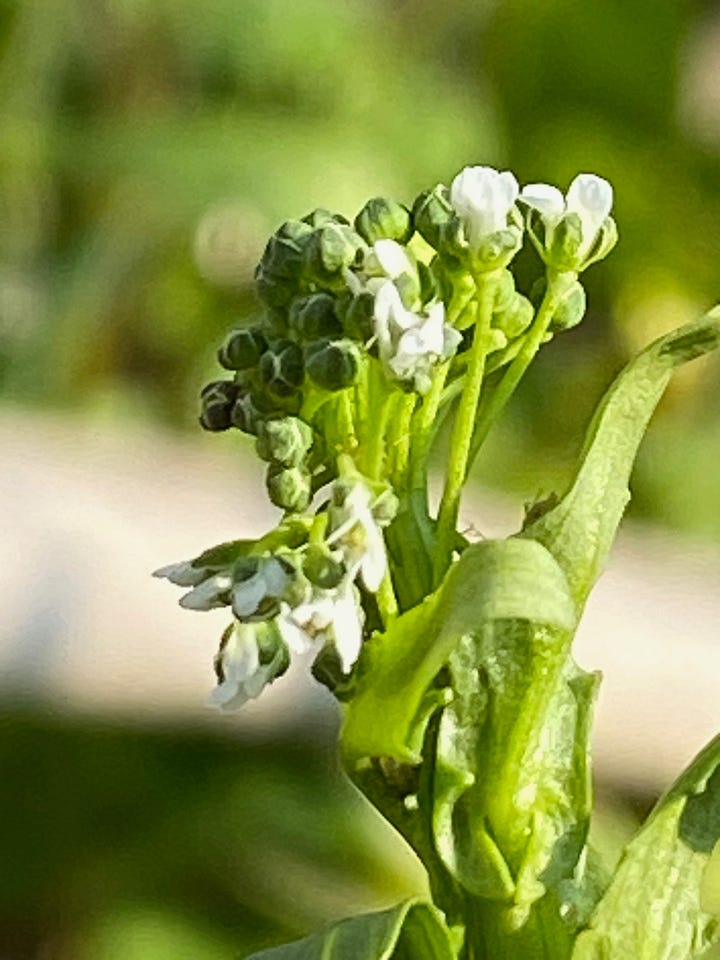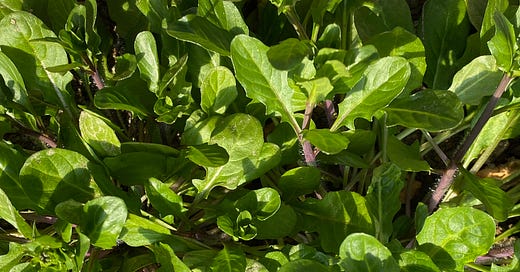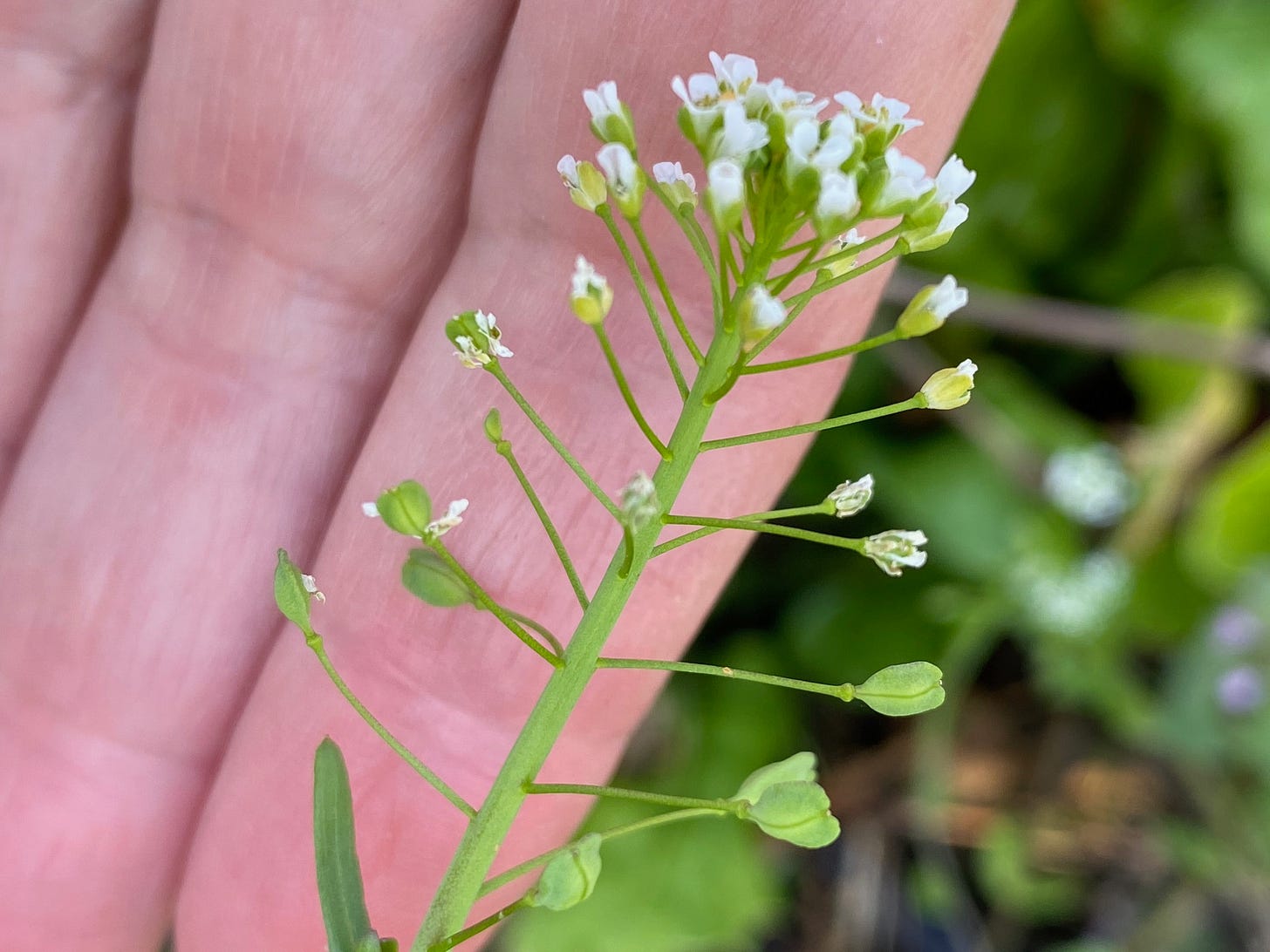This week’s weed special is Shepherd’s purse a.k.a. Capsella bursa-pastoris, as well as a plethora of common names such as pepper plant, shepherd’s bag, shovel plant, shepherd’s pouch, witches’ pouches, toothwort, mother’s heart, and that’s not all. Most of these names are evoked by the shape of the seed pods. Capsella means “packet” or “little box”, bursa means “purse”, and pastoris refers to shepherds. Hide the little kids’ eyes so we can tell you how shepherds, way back in the day, made their purses. The male sheep, or ram, has his own little sack, holding his precious male gems. When he got butchered, all of his parts were utilized ( shame to waste ) including his scrotum. This became the purse, and inspired by its morphology, the name of this wonderful weed. Back to the botany, shepherd’s purse belongs to the mustard and cabbage family, Brassicaceae, earlier known as Cruciferae.
Finding shepherd’s purse among the early weeds of spring is a challenge. They all look alike— not really, but almost. We have gained whatever competence by watching our weeds through the seasons, seeing and tasting the tiny weeds that grew up from where the adult weeds ended their life cycle. Shepherd’s purse is pretty challenging, because the leaves of the rosette are polymorphous, depending on growth conditions. They can be deeply or lightly lobed, and have variable amount of hair. This Utah State U. extension site has a good pic showing the variability of the basal leaves. When the leaves are tiny, the lobes are not very conspicuous.
Most foraging books, and sites, etc., will show you the adult plant, that has bolted to seed. By then, it’s too late to have a shepherd’s purse salad, but you might be able to spice things a little with the seed pods. The adult plant can still be used for medicine as long as it’s not too dried out. We think Josh, at Trillium Wild Edibles is a skillful, patient teacher, so we linked him to show you the distinctive flowers and seed pods of the adult plant. His vid is totally worth the time. There’s a good chance you have seen this distinctive weed, and can go back to where you found it last year to see what’s growing now, or in a few weeks. Here’s what we see now…


Shepherd’s purse sprouts out as a green or purple stemmed plant with hairless cotyledons (the first 2 leaf-like things you see before true leaves form). The initial stems and leaves that form can be hairy. Later the leaves can have sparse to no hairs on the upper side, and perhaps hairs on the mid vein underneath. Leaves forming the initial rosette can vary from very slightly to deeply lobed and can grow up to 6 inches long and up to 1.5 inches at the tip. The stem(s) arising from that rosette, are hairy at the base, but not at the upper part as it grows. A group of 15 or more flowers forms at the top of the stem, and more of such groups can emerge from the axils of leaves at the lower part of the stem. Leaves on the stem are smaller, oblong and about 2 inches or less long. Flowers are about 0.25 inches across, white with 4 petals and 4 sepals. The thin flower stalks reach about 0.5 inch in length. As the stem grows upward, pods gradually replace flowers, but leaves stop forming. You might see a foot of topmost stem with pods only, and no leaves on the adult plant. Each heart shaped pod contains 15 or so orange to deep red/brown seeds, which may survive in the ground for many years. Don’t worry, you will never run out of shepherd’s purse once you have it. We have linked some pictures here, and in the UK and will update with our own pics when we have them. (It’s so hard to plan ahead :)
March update pic.
A main lookalike to shepherd’s purse is field pennycress, Thlapsi arvense. It has smoother leaves in the basal rosette, and tends to grow a good deal taller. When the stem shoots up, leaves rise closer to the top, and the clefted flattened seedpods are grouped higher on the stem. It gives the appearance of a branched bottlebrush. This weed becomes stinkier with age, but not to worry if you confuse a little rosette of field pennycress with our weed of choice. The pennycress is also edible when young. However, the seed pods are more problematic to livestock if they eat too much of it. It can taint the milk of cows with its sulfurous nature. You can check this video from Edible Wild Food for comparison.
Shepherd’s purse is one of the most widely distributed plants in the world, and has been called the second most common weed. It’s phenotypic variability perhaps accounts for this adaptability and ubiquity. Depending on factors such as environmental conditions and day length, this weed has varying bolting time flowering time, leaf shape, branching, etc. The morphology of the flowers and the pods are the most constant characteristics. The seeds have a most peculiar quality of being attractive to nematodes to which they are toxic. The killed nematodes then serve as soil amendments for the betterment of shepherd’s purse nutrition. (So this plant is a bit on the carnivorous side, but not as overtly as a venus fly trap or pitcher plant.) The seeds have been used to control mosquitoes in ponds. It seems that they become sticky when wet, and bind up the mouths of mosquito larvae.
Shepherd’s purse is harvested wild everywhere, but perhaps most famously in China, stuffed in wontons, in Korea, and in Japan where it has a place in ceremonial food at the spring time festival. The young leaves, which are currently being nibbled on in Weedom-land, have a very mild, agreeable cabbage taste with little mustard spice. They go straight into the salad, and can be hidden wherever we would put spinach, kale, or collards. Float them in some soup. The seeds can be used as a mustard or pepper substitute. Like chickweed, this herb contains some oxalic acid, so eating large bales of it is discouraged.
Medicinally the top historical use for Shepherd’s purse seems to be to control or stop bleeding both internally and externally. It’s traditionally used in midwifery after (not before) delivery for excessive post partum bleeding, and has been used for excessive menstrual bleeding for any reason, including fibroids and endometriosis. It has also been used for hemorrhoids, urinary and GI bleeding, and as a diuretic. Other medicinal uses have been to control diarrhea, and to treat jaundice, eczema and rashes. Various sources mention its ability to either increase or decrease blood pressure. This is possible, and the term for such herbs is amphoteric. Excessively huge quantities of this herb can act as a CNS depressant, cause heart palpitations, and possibly affect thyroid function. Use of medicinal amounts during pregnancy is contraindicated due to the oxytocic effects on uterine smooth muscle, which has been attributed to a peptide constituent.
An overview of constituent classes to be found in shepherd’s purse follows. Nutritional components include various amino acids, generous vitamin A, 5000 IU per 100 grams, and Vitamin C, 91 mg/100g, unspecified amount of vitamin K, fatty acids, and relatively high amounts of calcium, chromium, potassium and sodium are present. Other constituents include array of flavonoids, amines, phenolic acids, resins, saponins, alkaloids, mustard oil glucosides such as sinigrin. More specific constituents and their activities will be addressed in Shepherd’s Purse 2, when we delve more deeply into the use of this weed as medicine.
Meanwhile, follow some of those links, given above, so you can find your shepherd’s purse. When it’s fully grown, the leaves won’t be as tasty, but the entire upper portion can be tinctured fresh, or dried and powdered for medicinal uses. Most references suggest that this herb should be used fresh, or fairly soon after drying for best activity. It is suggested to make new tincture yearly.
At Weedom, the spring peepers in our little swamp began their mating songs on Feb 16, which is a few days earlier than average. It’s our signal of impending Spring. Click this link for an hour of power :-) The chorus in that recording sounds a lot like our little frogs.
Where We Dig
1. Oyebanji BO, Saba AB, Oridupa OA. Anti-inflammatory and analgesic effects of methanol extract of Stellaria media (L.) Vill leaf. African Journal of Biomedical Research. 2012;15(1):29-34. doi:10.4314/ajbr.v15i1
2. CABI. Capsella bursa-pastoris (shepherd’s purse). CABI Compendium. 2021;CABI Compendium:11223. doi:10.1079/cabicompendium.11223
3. Capsella bursa-pastoris (Shepherd’s Purse) | North Carolina Extension Gardener Plant Toolbox. Accessed February 21, 2023. https://plants.ces.ncsu.edu/plants/capsella-bursa-pastoris/
4. Capsella bursa-pastoris Shepherd’s Purse PFAF Plant Database. Accessed February 8, 2023. https://pfaf.org/user/plant.aspx?LatinName=Capsella+bursa-pastoris
5. Ghalandari S, Kariman N, Sheikhan Z, Mojab F, Mirzaei M, Shahrahmani H. Effect of Hydroalcoholic Extract of Capsella bursa pastoris on Early Postpartum Hemorrhage: A Clinical Trial Study. The Journal of Alternative and Complementary Medicine. 2017;23(10):794-799. doi:10.1089/acm.2017.0095
6. Naafe M, Kariman N, Keshavarz Z, Khademi N, Mojab F, Mohammadbeigi A. Effect of Hydroalcoholic Extracts of Capsella Bursa-Pastoris on Heavy Menstrual Bleeding: A Randomized Clinical Trial. The Journal of Alternative and Complementary Medicine. 2018;24(7):694-700. doi:10.1089/acm.2017.0267
7. Field pennycress. SARE. Accessed February 21, 2023. https://www.sare.org/publications/manage-weeds-on-your-farm/field-pennycress/
8. Hutchens AR. Indian Herbalogy of North America. Shambhala; Distributed in the United States by Random House; 1991. https://openlibrary.org/books/OL1567124M/Indian_herbalogy_of_North_America
9. (PDF) The Effect of Hydroalcoholic Extracts of Capsella Bursa-Pastoris on Heavy Menstrual Bleeding: A Randomized Clinical Trial. doi:10.1089/acm.2017.0267
10. relative role of plasticity and demographic history in Capsella bursa-pastoris: a common garden experiment in Asia and Europe | AoB PLANTS | Oxford Academic. Accessed February 21, 2023. https://academic.oup.com/aobpla/article/14/3/plac011/6562764?login=false
11. Richard Whelan ~ Medical Herbalist ~ Herbs A-Z. Accessed February 8, 2023. https://www.rjwhelan.co.nz/herbs_A-Z.html
12. Shepherd’s purse – and the value of stories. Wild Plants, Foraging, Food, Art and Culture. Published June 25, 2020. Accessed February 21, 2023. https://www.diegobonetto.com/blog/shepherd-purse-and-the-value-of-stories
13. Peng J, Hu T, Li J, et al. Shepherd’s Purse Polyphenols Exert Its Anti-Inflammatory and Antioxidative Effects Associated with Suppressing MAPK and NF-κB Pathways and Heme Oxygenase-1 Activation. Oxid Med Cell Longev. 2019;2019:7202695. doi:10.1155/2019/7202695
14. University US. Shepherd’s-Purse. Accessed February 21, 2023. https://extension.usu.edu/pests/ipm/ornamental-pest-guide/weeds/w_shepherds-purse
15. Shepherd’s-purse. SARE. Accessed February 21, 2023. https://www.sare.org/publications/manage-weeds-on-your-farm/shepherds-purse/
16. Shepherd’s-Purse / Shepherd’s Purse / Shepherds Purse / Shepherds-Purse / perse - Wild Flower Finder. Accessed February 21, 2023. https://wildflowerfinder.org.uk/Flowers/S/ShepherdsPurse/ShepherdsPurse.htm
17. Shepherd’s Purse. White Rabbit Institute of Healing. Accessed February 21, 2023. https://www.whiterabbitinstituteofhealing.com/herbs/shepherds-purse/
18. Shepherds Purse: Pictures, Flowers, Leaves & Identification | Capsella bursa pastoris. Accessed February 8, 2023. https://www.ediblewildfood.com/shepherds-purse.aspx
19. Cornille A, Tiret M, Salcedo A, et al. The relative role of plasticity and demographic history in Capsella bursa-pastoris: a common garden experiment in Asia and Europe. AoB PLANTS. 2022;14(3):plac011. doi:10.1093/aobpla/plac011







